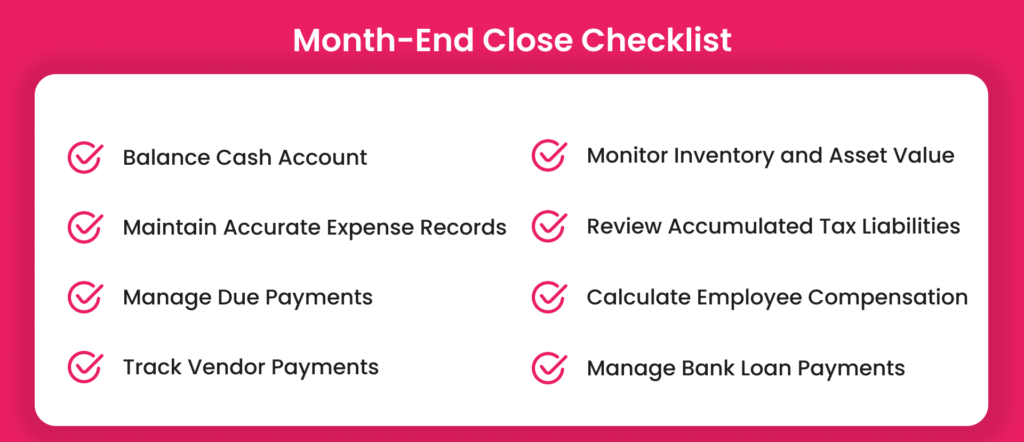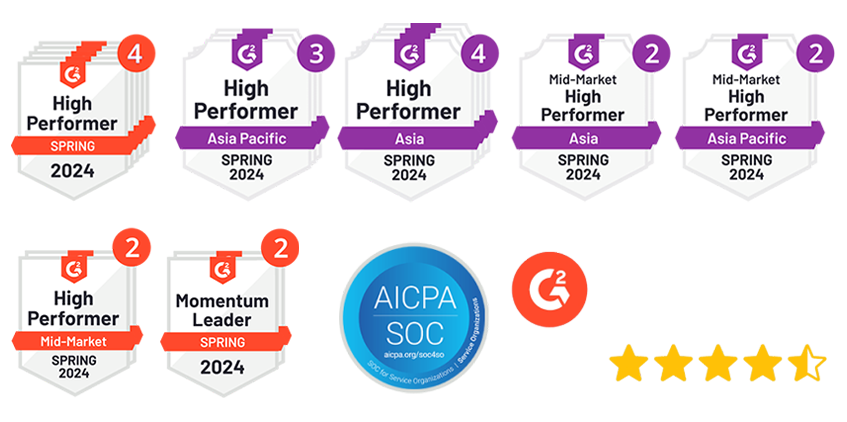A month-end close checklist plays a crucial role in facilitating a seamless and successful closing process. It serves the purpose of offering clear visibility into the status of each task, effectively managing resources and deadlines and minimizing confusion during turnover or changes in roles and responsibilities.
This blog aims to enlighten finance teams on elevating their month-end close process through the implementation of a strategic checklist. By following this checklist, teams can enhance their efficiency, ensure accountability, and optimize the overall month-end closing experience for improved financial management.
What is a Month-End Close Checklist?
A month-end close checklist is a systematic set of tasks that finance teams undertake to finalize a company’s financial records at the end of each month. This checklist ensures the accuracy of financial data, including reconciling bank statements, updating journal entries, and verifying accounts receivable and accounts payable. It involves reviewing and adjusting various financial aspects, such as fixed assets, prepaid expenses, and accruals. The process comprises the preparation of essential financial statements, such as the income statement and balance sheet.
The month-end close checklist serves as a comprehensive guide to meet regulatory compliance, identify discrepancies, and facilitate effective communication among the finance team members. Ultimately, the month-end close checklist is crucial for providing reliable financial information that supports informed decision-making within the organization.
Why Does the Finance Team Need a Month-End Close Checklist?
Finance teams that delay monthly or, even worse, year-end financial closing face the challenge of compiling extensive reports under tight deadlines. It results in scrambling to gather documentation from the entire year, leaving little time and energy to spare.
While tackling periodic financial closings may seem overwhelming, addressing them every month makes it much easier to monitor the company’s finances consistently throughout the year. This approach allows for a more reliable and accurate understanding of the business’s financial status, uncovering opportunities for cost savings in day-to-day operations.
By performing reconciliations during month-end closing, businesses can significantly reduce the time needed for quarterly and annual financial closings. This proactive approach not only streamlines the process but also ensures a more organized and efficient financial management system.
During the month-end close, finance teams need to shift their attention to crucial tasks:
- Summing up income and revenue.
- Balancing company expenses.
- Scrutinizing bank accounts and statements.
- Compiling essential financial statements:
- Profit & loss statement, outlining earnings and expenditures.
- Balance sheet, detailing all assets and liabilities.
- Cash flow statement, recording cash balance and all transactions.
Therefore a month-end close checklist is essential for finance teams for:
Accuracy and Reliability: The checklist ensures that financial records are accurate and reliable. By systematically reviewing and reconciling accounts, errors, and discrepancies can be identified and corrected, leading to more trustworthy financial information.
Timeliness: The checklist helps in completing financial tasks on time. The month-end close process ensures that financial statements are prepared promptly, providing management with up-to-date information for decision-making.
Compliance: Many industries and organizations have regulatory requirements and accounting standards that must be followed. The checklist helps finance teams ensure compliance with these regulations, reducing the risk of legal issues and financial penalties.
Decision-Making Support: Accurate and timely financial information is critical for effective decision-making. The month-end close checklist ensures that financial data is reviewed thoroughly, providing management with the insights needed to make informed strategic decisions.
Communication and Collaboration: The checklist serves as a communication tool within the finance team. It outlines responsibilities and tasks, promoting collaboration and ensuring that everyone is on the same page during the month-end close process.
Identification of Issues: Regular reconciliation and review of financial accounts through the checklist help identify and address issues promptly. This proactive approach minimizes the risk of financial misstatements and facilitates problem resolution before it escalates.
Documents Need for Month-End Close Checklist
To ensure a timely completion of the closing process, it’s important to have the following elements ready:
- Total income or revenue
- Accounts receivable
- Expense receipts and supplier invoices
- Bank accounts and statements
- Petty cash totals
- Inventory total
Depending on your business and industry, you might need additional required documentation.
The purpose of using this month-end close checklist is to make the entire process more manageable. By breaking it down into smaller steps, it becomes easier to focus on each task, reducing the chances of errors or missed deadlines.
Checklist to Streamline Your Month-End Closing Process
We’ve outlined the essential steps to help you close the books on time.

Balance Cash Account
Ensure your cash balance aligns with bank statements, identifying and addressing any discrepancies or undeposited funds promptly. This step enhances financial accuracy and minimizes errors in your cash records.
Maintain Accurate Expense Records
Record and double-check company expenses for the period, ensuring precision in your financial records. Accurate expense tracking is vital for a comprehensive understanding of your financial standing.
Manage Due Payments
Review the status of due payments, assessing the need to write off any bad debt. This proactive approach helps maintain healthy cash flow and avoids potential financial losses.
Track Vendor Payments
Cross-confirm payments made to vendors during the month, fostering transparent and reliable relationships. Accurate supplier payment tracking ensures proper financial management and strengthens vendor partnerships.
Monitor Inventory and Asset Value
Document the depreciation value of fixed assets and keep a close eye on inventory levels. This practice aids in assessing the overall financial health of the business and supports strategic decision-making.
Review Accumulated Tax Liabilities
Thoroughly check for any accumulated tax liabilities for the relevant period. This step ensures compliance with tax regulations and helps prevent financial surprises during audits or tax filings.
Calculate Employee Compensation
Calculate employee payroll for reimbursement accurately. This step is crucial for maintaining employee satisfaction and adhering to labor regulations, contributing to a smooth month-end closing process.
Manage Bank Loan Payments
Calculate monthly interest costs payable to the bank and amortization of loans. Effectively managing bank loan payments ensures financial stability and minimizes the risk of late payments or penalties.
Closing Thoughts
Despite having a month-end close checklist, finance teams often face challenges due to incomplete or missing documentation, such as lost paper records and incorrect data entries. In such situations, having reliable tools becomes crucial.
Finance solutions like Peakflo can reconcile accounts quickly, reducing the time from days to minutes. The Automated Reconciliation feature automates repetitive processes, giving finance teams the power to manage the financial close efficiently. With these tools, even the most well-prepared finance teams can overcome obstacles and streamline their processes for a smoother month-end close.










![Why AI Sales Calls Are Making Good Sales Reps Even Better [2025 Guide] ai sales calls](https://blog.peakflo.co/wp-content/uploads/2025/09/65168cf6-3001-4733-8cbc-12d5684cf449-218x150.webp)



































